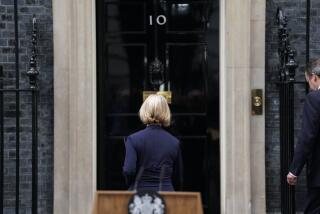Britain’s well-stocked Cabinet
- Share via
On the afternoon of May 7, assembling in the opulent St. Stephen’s Club in London, Britain’s political journalists — weary from the election night before and excited about the fact that no party claimed a majority of seats in Parliament — raised their eager faces as Conservative Party leader David Cameron entered and took his place at the lectern.
To form a government, Cameron would need to ally himself with some of his opponents after a bitter campaign. Many doubted his ability to do so.
“I want to make a big, open and comprehensive offer to the Liberal Democrats,” Cameron said, referring to the party that finished third in the balloting. “I want us to work together in tackling our country’s big and urgent problems.”
No one thought it could happen.
And when it did, no one thought the subsequent coalition between Conservatives and Liberal Democrats would last out the summer.
Wrong again.
What’s more, the coalition has brought back “Cabinet government,” a process through which government ministers reach decisions collectively after debate and compromise — an important safeguard against government according to the dictates of one person.
Since the early 1980s, Britain’s prime ministers moved the political system from its traditional Cabinet format to something more akin to the U.S. presidential system. In this regard, previous Prime Minister Gordon Brown of the just-dethroned Labor Party was perhaps the most controlling. “Gordon wants to interfere in everything,” said Geoff Hoon, a Cabinet minister under Brown and his predecessor, Tony Blair.
In Cameron’s government, by contrast, everything has to be “coalitionized,” said the Cabinet secretary, Gus O’Donnell, or G.O’D., as he’s known. G.O’D. was responsible for bringing the parties together in May’s negotiations, and now ensures the coalition runs smoothly. The two parties are not obvious bedfellows, but they have formed a solid “brokeback coalition.”
Together, Cameron and Liberal Democrat leader Nick Clegg are overseeing some of the most radical cuts to government spending in the world. Not surprisingly, tensions have appeared, though not really between Conservatives and Liberal Democrats, but among Conservatives themselves — notably between George Osborne, the chancellor of the exchequer, and former Conservative leader Iain Duncan Smith, the secretary of state for work and pensions. The two men, at times swearing at each other across the Cabinet table, disagree about how to reconcile severe spending cuts with tackling poverty. But disagreement between the treasury and a big-spending department is only natural. Indeed, it’s healthy. It’s what a Cabinet is for. After all, politics is about advancing the public interest through conflict followed by compromise.
Britain’s rare coalition governments are generally associated with times of national crisis. There was a Liberal-Conservative coalition during World War I, under Herbert Asquith and then David Lloyd George. After the war, the Lloyd George coalition continued in office for a further four years until 1922, a period generally considered to have been a disaster. Lloyd George, known at the time as “the man who won the war,” ruled as an “elective dictator,” contemptuous of Parliament and the Cabinet system. His coalition was brought down primarily by Conservative backbenchers and junior ministers angry at the prime minister’s Caesarism.
If there’s a lesson here, it’s that coalitions cannot work without an effective Cabinet.
After the global financial crisis of the late 1920s, coalitions formed again from 1931 onward and continued, lastly under Winston Churchill, until the end of World War II. Under the label of “national governments,” they generally encompassed a strong Cabinet, though Churchill became increasingly presidential in tone. But then, those were hardly ordinary times.
The national governments were unwilling to perpetuate coalitions and therefore eschewed electoral reform that would make them more likely in the future. The current coalition, however, talks of moving toward an alternate-vote system, under which voters can rank their first and second preferences among candidates. If no candidate wins a majority with the first choices counted, the second choices are tallied and the candidate with more than 50% of the vote wins. That format would rarely produce a party with an overall majority in the House of Commons. And peacetime coalition governments, so unusual at the moment, would become the norm, as they are in much of continental Europe, where they are often characterized by instability and paralysis.
In some ways, paralysis is also characteristic of U.S. politics. Writer Todd Purdum, in the latest issue of Vanity Fair, describes how Washington has become “depressing and dysfunctional.” The sheer hatred between the two parties has eliminated bipartisanship.
“Without the internal partisan divisions that forced members to seek allies from the other party,” he writes, “there is no incentive for Republicans and Democrats to work with one another on anything.” Purdum’s essay comes not long after George Packer, in the New Yorker, described how the two parties simply refuse to compromise.
Until recently, Washington’s problems were also prevalent in Westminster, the seat of the British government. But the give-and-take of the prime minister’s Cabinet has a parallel in Parliament, which is becoming more effective and powerful. Cross-party outreach has blossomed in part because the prime minister’s coalition has critics within the two governing parties. The Conservative Party’s 1922 Committee, named after the revolt against Lloyd George, remains a potent force as a voice for the party’s right, despite Cameron’s efforts to neuter it. And there are splits too within the Liberal Democrats — between classical liberals, who share an intellectual tradition with Conservatives, and the party’s left, some of whom may even defect to the Labor Party.
The coalition, then, is unable to take the support of its backbenchers for granted. It is therefore necessary to engage in the art of politics, to argue, to persuade and — importantly — to compromise. British politicians are learning how to maneuver in an environment of coalition politics. In the process, they’ve become less loyal to their parties but more apt to get things done. Politicians in Washington should watch closely.
Grant is a constitutional law scholar at the University of Oxford.
More to Read
Sign up for Essential California
The most important California stories and recommendations in your inbox every morning.
You may occasionally receive promotional content from the Los Angeles Times.










